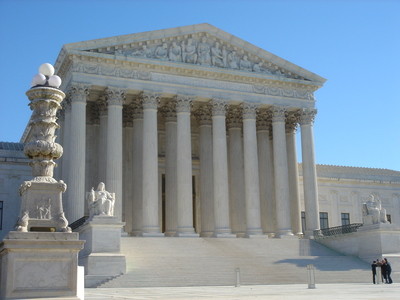Whither the 2016-17 Court on Environmental Cases?
Docket so far limited to a significant takings case, Murr v. Wisconsin
 So far, the docket for the U.S. Supreme Court’s term beginning in October includes no significant statutory environmental case. It does include an important takings case that could limit or expand the land use powers of all levels of government to protect wetlands, endangered species habitat, and other ecologically sensitive parcels. Whether the Court ultimately decides looming and giant environmental cases — including those involving the fate of wetlands protection and the validity of the Clean Power Plan — remains uncertain.
So far, the docket for the U.S. Supreme Court’s term beginning in October includes no significant statutory environmental case. It does include an important takings case that could limit or expand the land use powers of all levels of government to protect wetlands, endangered species habitat, and other ecologically sensitive parcels. Whether the Court ultimately decides looming and giant environmental cases — including those involving the fate of wetlands protection and the validity of the Clean Power Plan — remains uncertain.
The U.S. Supreme Court has decided numerous significant environmental cases over the past decade, including, of course, the landmark Massachusetts v. EPA. Front and center in virtually every dispute, either writing the majority opinion or a stinging dissent, was the late Justice Antonin Scalia. Over the next few years it will be interesting to see whether the Court continues to review the actions of the Environmental Protection Agency as closely as it has in recent years. My hunch — which of course could be wrong — is that Justice Scalia was not just a major intellectual force in opinion-writing in environmental cases but also the key to persuading three of his colleagues to take up environmental cases in the first instance. If I’m right, the Court may more frequently leave the review of major environmental cases to the lower courts.
The takings case that Court will hear some time in the fall (the oral argument is not yet set) may confirm the adage that bad facts make bad law. That’s because — as is often the case in takings cases that reach the high Court — the property owners at the heart of the dispute have sympathetic facts on their side but not necessarily the law. The sympathies they evoke could produce an outcome that makes sense in their case but not for overall takings doctrine. Property rights lawyers, who typically finance the litigation of the cases that reach the Supreme Court rather than requiring the property owner to pay onerous legal bills, have been very smart in which cases they choose to pursue. They typically finance cases brought by owners of small commercial properties or single family homes who are being heavily regulated or subject to eminent domain. The best example of the sympathetic homeowner is Susette Kelo, a nurse who lived in a 19th century home that the City of New London, Connecticut, wanted to destroy to make way for a new waterfront. The Institute for Justice, a conservative legal organization, represented her. Though Kelo ultimately lost her case, she and her lawyers set off a firestorm around the country and a huge legislative response.
The plaintiffs in Murr are also sympathetic, as are the facts in their case. They’re represented by the Pacific Legal Foundation, a conservative property rights organization. Here’s the background. The Murrs are six siblings whose parents, William and Dorothy, left them a riverfront cabin that they built in the early 1960s on close to an acre of land. The history of the purchase of the land on which the cabin is built is important. The senior Murrs first bought one parcel of land (Lot F) in 1960 and built the cabin and then bought an adjacent parcel in 1963. The 1963 lot (known as Lot E) remains vacant to this day. The senior Murrs transferred the parcels to their children in two separate transactions, Lot F (the cabin) in 1994 and Lot E (the vacant lot) in 1995. The effect of the 1995 transfer to the children technically and legally made the lots a single unit for purposes of development — in legal parlance resulted in a “merger” of the two lots into a single one. St. Croix County, where the parcels are located, prohibits the sale or subdivision of a portion of a vacant lot that is less than one acre. The Murrs’ lot is just under an acre.
After a number of years and several floods that damaged the cabin, the Murr children flood-proofed the cabin and sought to sell the vacant lot (Lot E). The St. Croix ordinance, of course, prohibited such a sale. The Murr children are arguing that in preventing the sale the County has “taken” their property under the 5th Amendment to the U.S. Constitution. The gist of the argument is that Lot E is a separate parcel of property and that if it were owned by someone other than the six children who also own Lot F they could sell it. Instead, St. Croix is “taking” 100 percent of the value of their property by refusing to allow them to sell it or develop a separate house on it.
From a constitutional law perspective, the Supreme Court has made clear that a government cannot enact a regulation that deprives a property owner of 100 percent of the property’s economic value absent exceptional circumstances not relevant here. The seminal case is Lucas v. South Carolina Coastal Council. The complicated part of determining whether a regulation has eliminated 100 percent of a property’s economic value is what “property” to apply the test to. Wisconsin in the Murr case is arguing (and the Wisconsin lower courts agreed) that the parcel is Lot E and Lot F combined. That means that a regulation barring the Murrs from selling Lot E takes only a portion of the value of their land because they still have a valuable cabin on it (adjacent to a nice bit of land when the two lots are combined). The Murrs are arguing, instead, that the two parcels should be treated separately. The Supreme Court has been less than clear about how to think about this question or, to use Justice Scalia’s words in a famous footnote (note 7) in Lucas, the Court has created “uncertainty” in the “composition of the denominator” in determining what portion of the property matters for deciding whether a government has taken 100 percent of its value.
What makes the Murr case difficult is that the parcels were at one time under separate ownership and were separately transferred. If they’d remained as separate parcels the Murr children could sell Lot E under the terms of the ordinance. Moreover, if the parents had thought about trying to circumvent the ordinance they could have done so easily by transferring the lots to different groups of children. The Wisconsin Court of Appeals, however, rejected the Murrs’ arguments that the parcels were separate and upheld the county’s refusal to grant them a variance from the ordinance in order to sell the vacant parcel.
So what will the Supreme Court do with the case? Here’s where Justice Scalia’s influence is still being felt on the Court. The Murrs’ petition of certiorari to hear the case was granted before Justice Scalia died. He was almost certainly one of the four votes to grant the cert. petition. Had the case come before the Court after his death it’s highly likely that the petition would have been denied. Without a ninth member of the Supreme Court, it seems almost predictable that we could see a 4-4 split in the outcome despite the sympathetic plaintiffs. If the vote is tied, that means that the Wisconsin Court of Appeals opinion will stand and the Murrs will not be able to sell Lot E.
Reader Comments
One Reply to “Whither the 2016-17 Court on Environmental Cases?”
Comments are closed.







I think it is worthwhile to note that in the 46 years since passage of the National Environmental Policy Act (NEPA) of 1969 the Supreme Court of the United States has heard 17 cases involving NEPA claims. NEPA requires a “detailed statement” (now known as an environmental impact statement) by all Federal agencies proposing “major Federal actions significantly affecting the quality of the human environment.” (P.L. 91-190, Sec. 102(2)(C)) In each of those 17 cases the Supreme Court ruled in the government’s favor. In other words, the NEPA plaintiffs lost all cases in the Supreme Court. In all 17 cases, the NEPA plaintiffs won in the lower courts. Even though the government won those 17 cases by a large majority of the Supreme Court, it would be very interesting to see how a new NEPA case would fare with an eight-member Court.